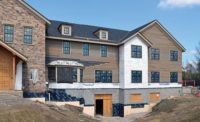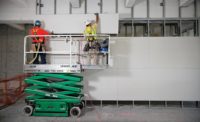The expectation of speed in building construction today means deadlines are a constant challenge for installers. Add to that changes in project scope, unexpected delays or difficulty obtaining materials, and the contractors’ jobs become even more difficult.
In the case of science and tech company EMD Performance Materials’—part of Philadelphia’s Navy Yard business campus—a tighter-than-usual project timeline placed high installation demands on the construction team. Fortunately, a change in specification brought on a ceiling product with out-of-the-box hardware and templates that helped installers use methods to keep the project on pace rather than miss deadlines.
Defining the Space
The four-story LEED Gold certified structure was constructed in 2016. In late 2017, EMD Performance Materials—a science and tech company that develops applications in fields such as consumer electronics, semiconductors, lighting, coatings, printing technology, plastics, and cosmetics—moved into the building’s first and third floors.
The work EMD’s employees undertake day in and day out demands a high-performance environment that can accommodate for everything, from lab research to accounting, facilitating the need for solo work, small group collaboration and large meetings. So when Herbst-Musciano LLC and HF Planners—the architectural team who designed EMD’s office—developed plans for the space, they aimed for functionality that served EMD’s collaborative work processes and a vast open floor plan with high ceilings that inspired employees to think big.
“We wanted unobstructed views and floating ceilings, and getting the ceilings as high as possible.” says architect Gary Musciano,
While visually appealing, that openness presented acoustic challenges, and as a result, required the right acoustic ceiling product and clever problem-solving in the installation process.
Finding the Right Product
In open spaces—especially office spaces—ambient and resonant noise can become a major disruption to employees’ concentration, work and well-being. Musciano created a specially designed ceiling in varying sections to help control acoustics and ensure that small groups collaborating at a table area wouldn’t disrupt the workflow of individuals working at nearby desks.
Over the main portion of the office, the ceiling consists of fields of gridded unconventional 1-foot by 8-foot narrow-reveal panels, from which tiers of strategically placed frameless 4-foot by 4-foot clouds hang freely to absorb ambient noise. And in smaller sections of the office space, 4-foot by 4-foot clouds were to be suspended from the deck at gradually increasing angles that ascend up the walls into the ceiling in a wave-like effect that captures resonant sound vibrations.
“With that,” explains Jeremy Kramer, estimator and project manager for Blasz Construction, the subcontractor responsible for the ceiling installation, “there was a challenge in finding the right product.”
The design team had originally specified a competitor’s products for the entire ceiling. The unconventional angling of the free-hanging clouds, however, meant that both sides of many of them would be in full view. They needed to block sound—but they also needed to look attractive from any and all angles. This revealed a significant flaw with the original product.
“The original products specified weren’t finished on the back and there was an upcharge to finish the back,” Kramer notes. Finishing the backs also would’ve meant a longer lead time to get them.
Kramer worked with Sherrie Stewart, acoustical sales manager for building materials distributor Builders FirstSource, to recommend CertainTeed. The company’s Ecophon Solo and Symphony lines provide acoustic performance and visual appeal, and the Solo line of clouds are manufactured with both faces finished. Regardless of their free-hanging orientation, Solo clouds show a clean, finished surface from any angle.
Thanks to the partnerships of the manufacturer maintains with its suppliers, Stewart is a knowledgeable supplier who was equipped to help fulfill the change in specification. And nearly all the products required by the EMD construction team were in-stock at a nearby distribution location, which significantly cut down on lead time.
Simplicity and Speed in Installation
In addition to the acoustic and aesthetic benefits of the clouds, the factory-supplied aircraft cable hangers and templates for placement of anchors offer the benefit of fast, easy installation with no need for special components or tools.
Phase one of construction on EMD’s office space, which included the office fit-out and ceiling installation, was aggressive and slated for 12 weeks, spanning over October, November and December. Joe Carroll, Blasz Construction’s on-site foreman for the project, says that the timeline is five to six weeks shorter than the typical timeframe for an installation of this size and scope. But EMD’s pending move, combined with the scheduling demands of subsequent project phases, meant the ceiling had to be installed swiftly.
“The open concept and clouds, combined with the traditional grid and panel sections, made the fit-out a lot harder,” says Carroll.
But the templates and easily adjustable hanger wires, along with some clever problem-solving on Carroll’s part, made quick work of installing the clouds, allowing the crew to stay on schedule.
For starters, Carroll said he and his team could move quickly because it was so easy to get a nice, clean cut on the panels. Second, every Ecophon Solo cloud includes a template to assist in anchor placement.
“The templates that are provided out of the box are amazing,” says Shawn McPeake, one of the installers on the job. “You can lay out the clouds on the ground, put the templates on the clouds to line up anchors for the hanger wires. Everything is level and plumb—it’s beautiful.”
Third, the manufacturer’s cables have adjustable push-button anchors that allow installers to easily adjust cloud heights by pressing a small button on the anchor.
“Other manufacturers’ systems don’t have that,” says McPeake, “and it’s a lot more difficult to move ceilings up and down into the position you want.”
The Added Benefit: Durability
With the pace of most jobs, ceiling panels are often installed and removed a number of times throughout the process to make way for fixtures and other components.
“At least 15 percent of ceiling tile typically gets damaged through the construction process,” says Carroll. “I’ve found that CertainTeed tile withholds durability through the construction process a little longer than other major manufacturers’ products. Putting in tiles, taking them out—they don’t get damaged.”
The Right Ceiling for the Space
The new specification not only met Herbst-Musciano’s architectural and aesthetic goals, it helped the project stay within budget and remain on time in the accelerated schedule. The result is a ceiling structure that performs acoustically and aesthetically in the vast office space.
The installation was such a success that it was recognized in April with an Acoustical Ceiling award from the Interior Finish Contractors Association for being a “project using high performance materials.” The IFCA is the principal union interior contractors association in the Philadelphia and Southern New Jersey Trade Area.
Like the installers, Musciano was also pleased with the change in specification.
“We really had to hang our hat on the performance of the ceiling,” he says. “[The manufacturer] had good systems that helped us achieve the structure of floating ceiling panels—and it was an available system. We didn’t have to look too hard or invent things. We had all the components, just by the way the products are manufactured.”










Report Abusive Comment